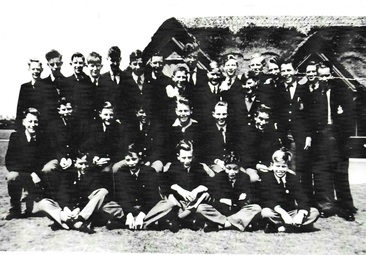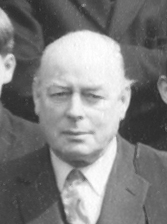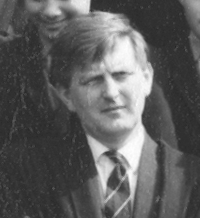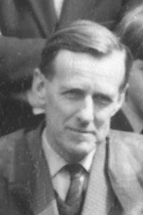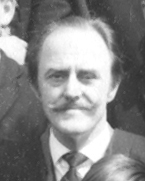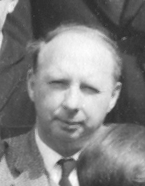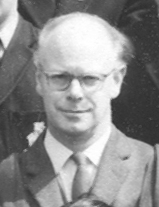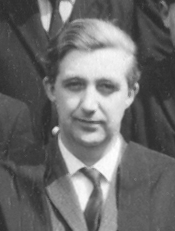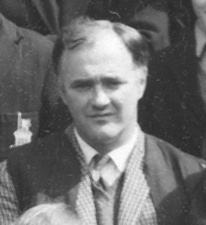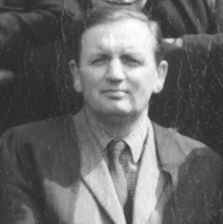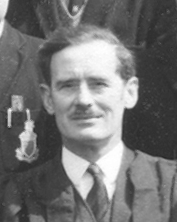Old Pastonian Recollections - School and Masters
The following is a selection of unofficial recollections of School life and in particular some stories of the various masters. If this stimulates recollection of your own, please submit them via the Upload Page and certainly feel free to challenge, correct, augment any of the descriptions here.
Video Tours...
Firstly though, I've been meaning to upload a virtual tour of the School and environs. So far I have only managed a few shakey snippet, but I put them here as a start. Hope you like them. Its a rough edit, and yes its Wagner.
|
|
|
|
|
|
Tour Playlist...
Nelson Snowman
Adam Thomas, PGS 1977-1979 - recounts the following:
"The ‘new’ 6th form common room. Making a 10ft snow Nelson one night outside t staff room windows, looking in through his telescope. The telescope had dropped off by the morning and staff sought the makers of what they took to be a large snow phallus. Robert Watson and I never owned up!"
"Perhaps more amusing is the account I was told, upon arrival at the school, of the 5th formers a few years previously, filling the organ pipes with pillow feathers, so that when the organ was played, at the end of year assembly, the hall became filled with decending white duck down, "a veritable blizzard", which accompanied "a particularly enthusiastic and vocal rendition of the school song"!
It would be great if a photo surfaced, of either.
"The ‘new’ 6th form common room. Making a 10ft snow Nelson one night outside t staff room windows, looking in through his telescope. The telescope had dropped off by the morning and staff sought the makers of what they took to be a large snow phallus. Robert Watson and I never owned up!"
"Perhaps more amusing is the account I was told, upon arrival at the school, of the 5th formers a few years previously, filling the organ pipes with pillow feathers, so that when the organ was played, at the end of year assembly, the hall became filled with decending white duck down, "a veritable blizzard", which accompanied "a particularly enthusiastic and vocal rendition of the school song"!
It would be great if a photo surfaced, of either.
ITV Nelson Documentary (1971)Pete Barr also provided his recollection about the Nelson Documentary from Anglia TV, 1971.
Looking for an archive of the documentary, I stumbled across this interesting archive site: http://www.eafa.org.uk/ Well worth a browse some time, but doesn't contain the item in question. Summary HERE |
|
BBC
"When the school took part in “Top of the Form” on BBC TV in the mid sixties one of the questions was “when was the school founded?” The answer given was 1606, to which the reply from the question master was “no 1604”. The school assembly the following day the headmaster clarified that 1604 was indeed the correct date but the school song was not incorrect but regrettably I cannot recollect his argument (but sure as eggs are eggs) he would have been absolutely correct."
This of course contradicts the info given on this web site but is a good topic for tiresome debate!
Apparently they progressed to the final, only losing out on a question about Marie Curie.
Thanks to Barry Maskell
This of course contradicts the info given on this web site but is a good topic for tiresome debate!
Apparently they progressed to the final, only losing out on a question about Marie Curie.
Thanks to Barry Maskell
Bob Austin
Please can any Old Pastonian help?
During my Paston School days I travelled, like many other boys, daily between Cromer and North Walsham by train.
Around 1943-45 I remember one day seeing from the train window an American bomber which had landed un-damaged in a large field adjacent to the railway line.
Over the course of the next few weeks American engineers built a temporary run-way using interlocking metal planks and then one day it was gone.
I did not see the take-off and as it was not a 'crash site' the USAF library in Norwich has no record of the incident.
Please does anyone else remember the event and where it took place?
Thank you,
Bob Austin
Update: Feb 2016: There was extensive coverage of this in the N.Norfolk news and also on the Paston School Facebook group HERE
Frank Sharp 1956-61
Just to mention that :
George Cooper was awarded the MilitaryCross (MC) in WW 11.
Doker was said to have flown Hurricanes (ed: or was it Lancaster Bombers?) -- and his brother? -- and they both had to have a cushions so thye could see over the nose of the aeroplane. Nice story.
Humph (Humphrey Grantham-Hill) (ed- or 'Granny'), the Maths Master was a brilliant teacher; he didn't suffer fools gladly or otherwise, and in summer he "knocked in" cricket bats.
GOS (Shuffery) taught French and I seem to recall that he spent the summer hiking around France (no hitching) with his beret; he looked like the proverbial French onion seller.
And where is Mr Atkinson, "Voco", to all and sundry, who taught Latin ?
Freddie Pointer was also a former Paston schoolboy and of course organised, rehearsed the annual cast for the annual Gilbert & Sullivan operetta.
Other teachers were "Watt" Tyler from Billingham who taught chemistry and whose favorite saying was "You get ought for nought out of Old Mother Nature".
Mr Bennett who taught physics (ex RAF) who died late 1950s with brain tumour.
Mr Mercer who took art.
Mr Blackmore who taught Maths (ex RN and suffered from what we thought of as shell-shock so we dropped our boxes of geometry instruments behind him!!) together with Spike and Humph.
Mad Maggie the Magyar who took gym and was fond of using the slipper on "lazy boys".
"Bouncer" Mattocks who taught biology, zoology and botany (used to stand on the platform next to his desk bouncing up and down on his toes). Can't remember the woodwork teacher's name (ed: was Mr Ball in my day, mid 70s?)
(thx Frank)
George Cooper was awarded the MilitaryCross (MC) in WW 11.
Doker was said to have flown Hurricanes (ed: or was it Lancaster Bombers?) -- and his brother? -- and they both had to have a cushions so thye could see over the nose of the aeroplane. Nice story.
Humph (Humphrey Grantham-Hill) (ed- or 'Granny'), the Maths Master was a brilliant teacher; he didn't suffer fools gladly or otherwise, and in summer he "knocked in" cricket bats.
GOS (Shuffery) taught French and I seem to recall that he spent the summer hiking around France (no hitching) with his beret; he looked like the proverbial French onion seller.
And where is Mr Atkinson, "Voco", to all and sundry, who taught Latin ?
Freddie Pointer was also a former Paston schoolboy and of course organised, rehearsed the annual cast for the annual Gilbert & Sullivan operetta.
Other teachers were "Watt" Tyler from Billingham who taught chemistry and whose favorite saying was "You get ought for nought out of Old Mother Nature".
Mr Bennett who taught physics (ex RAF) who died late 1950s with brain tumour.
Mr Mercer who took art.
Mr Blackmore who taught Maths (ex RN and suffered from what we thought of as shell-shock so we dropped our boxes of geometry instruments behind him!!) together with Spike and Humph.
Mad Maggie the Magyar who took gym and was fond of using the slipper on "lazy boys".
"Bouncer" Mattocks who taught biology, zoology and botany (used to stand on the platform next to his desk bouncing up and down on his toes). Can't remember the woodwork teacher's name (ed: was Mr Ball in my day, mid 70s?)
(thx Frank)
Peter Barrs - 1969-71
Pete’s Recollections
I started at Paston in the first year in September 1969, and made the arduous journey from Sheringham each day on the aged coach with the exhaust fumes coming in through the floor and tobacco fumes wafting down the aisle from the driver’s cigarettes.
I was put in Nelson House, so my reversible insipid green Tom Brown’s School Days replica football shirt had the yellow band across the chest, a colour I don’t think the heroic Horatio would been too happy about.
Mr Hawden
I remember meeting Harry Hawden for the first time in 1A English, and I immediately thought of Terry-Thomas. Some of the new boy introductions around his new charges went something like:
“Name?”
Sir, Adcock, Sir.”
“So nice of you to grace us with your presence, Sir Adcock”
And around the classroom:
“Bailey, Sir.” (in a heavy Norfolk dialect).
“Bile?”
“No, it’s Bailey, Sir.”
“Bile?”
Then a young lad from Happisburgh:
“Name?”
“Cole, Sir.” (in a heavy high-pitched Norfolk dialect).
“Coo-el?”
“No, Cole.”
“Coo-el?”
“No, Cole, Sir.”
“Coo-el?”
Then to Clive Smith of Sheringham:
“Smith, Sir”
“Welcome, Smithsir.”
The first book we read in English literature was The Hobbit, and although we did the usual thing of taking it in turns around the class to read out loud, Harry often took over to demonstrate his incredible talent for voices and diction. His lessons were always very enjoyable and obviously the memory has stayed with me all these years. It would have been nice to meet up with him in adult years as I would imagine he was a great raconteur in a market town pub setting.
Mr Grantham-Hill
I used to dread his classes, especially when his hay fever was making him more cantankerous than usual. He had a very short temper and it was hardly surprising that so many of us loathed the subject of Maths. Being in his class was always something of an ordeal, and you daren’t ask him anything for fear of getting your head bitten off. I always wanted to buy him flowers in the summer just to aggravate his condition even more, but I lacked both money and courage.
Mr Stannard
We had a lesson cancelled once and we ended up heading for the sports field to go swimming. None of us had any kit with us so we had the choice of skinny-dipping or going in wearing our underpants. The water was colder than a penguin’s chuff, and it wasn’t long before hypothermia kicked-in.
After surviving the Arctic water temperatures the only towels available were those crusty soiled ones from the lost property Black Museum; a tatty cardboard box brimming with long-forgotten cold, sweaty and often well-soiled sportswear some of which could stand up unaided.
Mr Macnamara
He was a tall bespectacled chemistry teacher in his 30s who looked a little like Richard Osman from Pointless. He had the habit of jumping up on the benches and strutting around on them during lessons, narrowly missing kicking over acid bottles. He was almost Monty Pythonesque in his demeanour and a South London sergeant-major voice.
In one lesson we were tasked with working out what the “mystery” chemical was in the flask:
“So, Massingham (Lee Massingham from West Runton) you big puddin’, what do you think is in the bottle; XCL or YCL?”
“XCL, Sir.”
“Very good, Massingham, and how did you reach that incredible conclusion?”
“It’s the first three letters of the registration number of my dad’s Zephyr.”
Mr Millington
In Physics lessons Mr Millington would enter the lab and utter his well-worn catchphrase:
“Stop making a noise. If you want to make a noise, make a noise quietly.”
We lost him for a term in the second year and had to endure a student teacher from up t’north somewhere, who spent weeks teaching us nothing but pin-hole cameras.
Tom Darby
Mr Darby was a young Canadian bespectacled geography teacher with a voice not unlike, Donald Sutherland. I recall one instruction he gave in class:
“Draw a diagram of the quay (but he pronounced it, “kwhy”) with your ink-sticks (felt-tipped pens).”
Mr Ken Marshall
When summoned to Ken’s office it was almost like meeting Winston Churchill. He never suffered anyone gladly, let alone fools so when we were often sent in disgrace for breaking the rules, being academically inept or just plain troublesome gits in class it usually ended in tears.
Mr Spielman
Mr Spielman was a Dutch French master and by that I mean he was from Holland and taught French. We had the cartoon OHP slide method of learning French with stick men and women featured on colourful backdops of hand-drawn boulangeries, boucheries and also a few voitures and chats scattered around in the pictures.
Poor Mr Spielman was a very nice man but had zero control over his class. Things started badly with people talking amongst themselves as he tried to teach, and in a very short space of time his classes had become dangerously disruptive. On a number of occasions others masters like Spike, Marty and Hovis has to sit-in to restore order.
Certain individuals made Mr Spielman’s life a complete misery, and the catalyst was when he’d spend a whole lunch-time writing out the lesson on the blackboard in very neat hand-writing in various colours. Immediately after lunch one pupil entered the classroom and deliberately wiped the board clean. An almighty row ensued with Mr Spielman chasing the pupil around the room, and the boy eventually smashed a chair and used a horizontal wooden cross-member to “knacker” the hapless master. The poor man lost his job because of our terrible behaviour, and we should have been thoroughly ashamed of ourselves.
Mr Brown
We were thrown in at the deep-end a bit with Latin. Rather than introduce us to the subject with interesting historical references and examples of how other languages evolved from it, it was delivered very much like the Roman Centurion John Cleese did to the graffiti daubing Brian in, “The Life of Brian”. None of knew anything about it, but Hovis insisted on giving us a ten-question test at the start of every lesson anyway.
Charlie Lamb
Charlie Lamb’s classroom always emitted an incredibly heady and soporific scent laced with essence of chalk dust. I still experience olfactic flashbacks to those history lessons today albeit without the chalk dust, when I am in a fragrance shop or someone walks by wearing a similar after-shave to Mr Lamb.
He was an enthusiastic teacher who introduced us to the fascinating world of Tutankhamen; enthralling us with tales of the curse released after Lord Carnarvon and Howard Carter’s discovery in the Valley of the Kings. It was very Boy’s Own adventure material in the way he presented it, and opened my eyes to all types of history.
We also studied Pompeii and I brought in a pull-out set of joined-up colour postcards that someone in the family had brought home from a holiday. Obviously, this was in the days before electronic graphical gadgetry has been invented so glossy postcards or maybe a photographic slide projector was about as good as it got.
The building of Stonehenge was another favourite he covered, and we spent ages illustrating our exercise books with drawings of the stones and detailed maps. I suppose nowadays kids would skip the creative bit and just grab images off the Net on their Smartphones or tablets, “Look what I can download, Sir”.
After my parents crossed the state line from Sheringham to Weybourne, I had to transfer to Fakenham Grammar. I went on a school trip to see the Treasures of Tutankhamun exhibition at the British Museum in 1972. It probably would have been more enjoyable had Charlie accompanied us. Unfortunately, my history teacher at FGS didn’t seem make the same connection with his charges, and studying such gripping events as The Chartist Movement for what seemed like months on end didn’t exactly help to stimulate the imagination of fidgety third formers.
Like most of the masters I knew, Charlie is no longer with us but I am grateful for having him teach me for a couple of years. He instilled in me a lifelong interest in history, so much so that if I had a pin-up girl on my wall today it would probably be, Dr Lucy Worsley.
The Singing Postman – Allan Smethurst (1927 to 2000)
It’s nice to see that an Old Pastonian is being commemorated with a blue plaque to be mounted on the wall of that most famous of Sheringham landmarks, the Town Clock. The Singing Postman shot to fame in the 1960s with albums as well as singles, and is best remembered for his hit about his chain-smoking sweetheart Molly Windley in, “Hev Yew Gotta Loight Boy.”
The unveiling should be taking place soon, pandemic permitting, so keep an eye on the Facebook page,
I started at Paston in the first year in September 1969, and made the arduous journey from Sheringham each day on the aged coach with the exhaust fumes coming in through the floor and tobacco fumes wafting down the aisle from the driver’s cigarettes.
I was put in Nelson House, so my reversible insipid green Tom Brown’s School Days replica football shirt had the yellow band across the chest, a colour I don’t think the heroic Horatio would been too happy about.
Mr Hawden
I remember meeting Harry Hawden for the first time in 1A English, and I immediately thought of Terry-Thomas. Some of the new boy introductions around his new charges went something like:
“Name?”
Sir, Adcock, Sir.”
“So nice of you to grace us with your presence, Sir Adcock”
And around the classroom:
“Bailey, Sir.” (in a heavy Norfolk dialect).
“Bile?”
“No, it’s Bailey, Sir.”
“Bile?”
Then a young lad from Happisburgh:
“Name?”
“Cole, Sir.” (in a heavy high-pitched Norfolk dialect).
“Coo-el?”
“No, Cole.”
“Coo-el?”
“No, Cole, Sir.”
“Coo-el?”
Then to Clive Smith of Sheringham:
“Smith, Sir”
“Welcome, Smithsir.”
The first book we read in English literature was The Hobbit, and although we did the usual thing of taking it in turns around the class to read out loud, Harry often took over to demonstrate his incredible talent for voices and diction. His lessons were always very enjoyable and obviously the memory has stayed with me all these years. It would have been nice to meet up with him in adult years as I would imagine he was a great raconteur in a market town pub setting.
Mr Grantham-Hill
I used to dread his classes, especially when his hay fever was making him more cantankerous than usual. He had a very short temper and it was hardly surprising that so many of us loathed the subject of Maths. Being in his class was always something of an ordeal, and you daren’t ask him anything for fear of getting your head bitten off. I always wanted to buy him flowers in the summer just to aggravate his condition even more, but I lacked both money and courage.
Mr Stannard
We had a lesson cancelled once and we ended up heading for the sports field to go swimming. None of us had any kit with us so we had the choice of skinny-dipping or going in wearing our underpants. The water was colder than a penguin’s chuff, and it wasn’t long before hypothermia kicked-in.
After surviving the Arctic water temperatures the only towels available were those crusty soiled ones from the lost property Black Museum; a tatty cardboard box brimming with long-forgotten cold, sweaty and often well-soiled sportswear some of which could stand up unaided.
Mr Macnamara
He was a tall bespectacled chemistry teacher in his 30s who looked a little like Richard Osman from Pointless. He had the habit of jumping up on the benches and strutting around on them during lessons, narrowly missing kicking over acid bottles. He was almost Monty Pythonesque in his demeanour and a South London sergeant-major voice.
In one lesson we were tasked with working out what the “mystery” chemical was in the flask:
“So, Massingham (Lee Massingham from West Runton) you big puddin’, what do you think is in the bottle; XCL or YCL?”
“XCL, Sir.”
“Very good, Massingham, and how did you reach that incredible conclusion?”
“It’s the first three letters of the registration number of my dad’s Zephyr.”
Mr Millington
In Physics lessons Mr Millington would enter the lab and utter his well-worn catchphrase:
“Stop making a noise. If you want to make a noise, make a noise quietly.”
We lost him for a term in the second year and had to endure a student teacher from up t’north somewhere, who spent weeks teaching us nothing but pin-hole cameras.
Tom Darby
Mr Darby was a young Canadian bespectacled geography teacher with a voice not unlike, Donald Sutherland. I recall one instruction he gave in class:
“Draw a diagram of the quay (but he pronounced it, “kwhy”) with your ink-sticks (felt-tipped pens).”
Mr Ken Marshall
When summoned to Ken’s office it was almost like meeting Winston Churchill. He never suffered anyone gladly, let alone fools so when we were often sent in disgrace for breaking the rules, being academically inept or just plain troublesome gits in class it usually ended in tears.
Mr Spielman
Mr Spielman was a Dutch French master and by that I mean he was from Holland and taught French. We had the cartoon OHP slide method of learning French with stick men and women featured on colourful backdops of hand-drawn boulangeries, boucheries and also a few voitures and chats scattered around in the pictures.
Poor Mr Spielman was a very nice man but had zero control over his class. Things started badly with people talking amongst themselves as he tried to teach, and in a very short space of time his classes had become dangerously disruptive. On a number of occasions others masters like Spike, Marty and Hovis has to sit-in to restore order.
Certain individuals made Mr Spielman’s life a complete misery, and the catalyst was when he’d spend a whole lunch-time writing out the lesson on the blackboard in very neat hand-writing in various colours. Immediately after lunch one pupil entered the classroom and deliberately wiped the board clean. An almighty row ensued with Mr Spielman chasing the pupil around the room, and the boy eventually smashed a chair and used a horizontal wooden cross-member to “knacker” the hapless master. The poor man lost his job because of our terrible behaviour, and we should have been thoroughly ashamed of ourselves.
Mr Brown
We were thrown in at the deep-end a bit with Latin. Rather than introduce us to the subject with interesting historical references and examples of how other languages evolved from it, it was delivered very much like the Roman Centurion John Cleese did to the graffiti daubing Brian in, “The Life of Brian”. None of knew anything about it, but Hovis insisted on giving us a ten-question test at the start of every lesson anyway.
Charlie Lamb
Charlie Lamb’s classroom always emitted an incredibly heady and soporific scent laced with essence of chalk dust. I still experience olfactic flashbacks to those history lessons today albeit without the chalk dust, when I am in a fragrance shop or someone walks by wearing a similar after-shave to Mr Lamb.
He was an enthusiastic teacher who introduced us to the fascinating world of Tutankhamen; enthralling us with tales of the curse released after Lord Carnarvon and Howard Carter’s discovery in the Valley of the Kings. It was very Boy’s Own adventure material in the way he presented it, and opened my eyes to all types of history.
We also studied Pompeii and I brought in a pull-out set of joined-up colour postcards that someone in the family had brought home from a holiday. Obviously, this was in the days before electronic graphical gadgetry has been invented so glossy postcards or maybe a photographic slide projector was about as good as it got.
The building of Stonehenge was another favourite he covered, and we spent ages illustrating our exercise books with drawings of the stones and detailed maps. I suppose nowadays kids would skip the creative bit and just grab images off the Net on their Smartphones or tablets, “Look what I can download, Sir”.
After my parents crossed the state line from Sheringham to Weybourne, I had to transfer to Fakenham Grammar. I went on a school trip to see the Treasures of Tutankhamun exhibition at the British Museum in 1972. It probably would have been more enjoyable had Charlie accompanied us. Unfortunately, my history teacher at FGS didn’t seem make the same connection with his charges, and studying such gripping events as The Chartist Movement for what seemed like months on end didn’t exactly help to stimulate the imagination of fidgety third formers.
Like most of the masters I knew, Charlie is no longer with us but I am grateful for having him teach me for a couple of years. He instilled in me a lifelong interest in history, so much so that if I had a pin-up girl on my wall today it would probably be, Dr Lucy Worsley.
The Singing Postman – Allan Smethurst (1927 to 2000)
It’s nice to see that an Old Pastonian is being commemorated with a blue plaque to be mounted on the wall of that most famous of Sheringham landmarks, the Town Clock. The Singing Postman shot to fame in the 1960s with albums as well as singles, and is best remembered for his hit about his chain-smoking sweetheart Molly Windley in, “Hev Yew Gotta Loight Boy.”
The unveiling should be taking place soon, pandemic permitting, so keep an eye on the Facebook page,
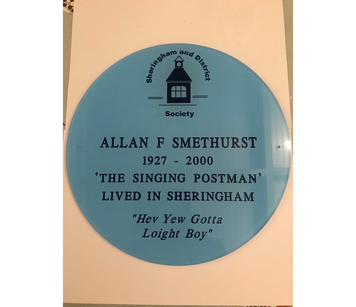
The Singing Postman Appreciation Society:
Tempo
Before starting at Paston we all had to buy an Oxford Helix Mathematical Set (which is still around today in the same tin) plus a fountain pen. Us poor kids had Woolworth’s Scripto scratchy ones in a set with a propelling pencil. The pen nearly always leaked into my blazer lining or shirt pocket whilst pencil leads would disappear inside the instrument at the slightest pressure on the paper, never to be seen again. Middle-class children had the more stylish and robust Platignums, whilst posh pupils had Parker pen sets some of which had been engraved. Bertram A Watts was the stationer of choice in Sheringham, and I’m sad that it closed its doors a few years ago after almost a century.
Being forced to use a fountain pen did improve many people’s hand-writing, but the downside was getting ink splattered on clothing and skin from pen-flicking fights. Books were often saturated with ink when the Quink bottle inevitable shattered inside your satchel (or if you owned a Parker, your briefcase). I remember buying turquoise ink just to be different, and I still use it. It’s amazing how many people I’ve come across over the years who were forced to use fountain pens at school, and they still prefer to use them today.
There was a TV ad campaign in the early 70s for the new Tempo felt-tipped pen, which the manufacturer claimed was the future of good writing. This wasn’t really the case because the ink often dried-up prematurely and the felt-tip soon softened and ended up like a frayed paint brush. The powers that be at Paston looked upon the Tempo as an instrument of the devil and just like the humble ball-point pen, they were outlawed. We were allowed felt-tips for colouring purposes, but traditional coloured pencils were longer lasting and you could shade drawings, diagrams and maps as heavy or as lightly as necessary.
Reports
Report time was the worst, and the only consistent thing I achieved was to always receive horrendous school reports. I should really have gone to Sheringham Secondary School, but passing that damned 11-Plus really put the mockers on it.
Sixteen miles to North Walsham on a fume-filled, rickety old coach and then seventeen miles to Fakenham on another fume-filled, rickety old coach. To paraphrase a song lyric by The Who, “Meet the new bus, same as the old bus.”
Anglia TV’s Nelson Documentary – Filmed at Paston in 1971
The Nelson documentary was produced by Anglia TV in 1971, and the television production team arrived at Paston to film in “yer actual” Nelson’s old classroom (used by Fred Pointer as the music classroom back then).
A few of us second year pupils with the longest hair (it was fashionable then) were picked to play Nelson’s school chums. The role of Nelson was shortlisted to three fair-haired boys; myself, a lad whose name I can’t remember and Peter Blakley. We were lined up to be scrutinised by the producer (can’t recall his name) and the director Harry Aldous. Peter had a remarkable likeness to a young Nelson in a portrait of him as a midshipman in the book Nelson by Arthur Bryant. He could also keep a straight face during the line-up so he was the natural choice.
We changed into period costume, and as I recall mine was black velvet shorty jacket and pantaloons. For authentic 1770 shoes we were given elasticated silver-painted buckles to place over our 1970 Tuf Town school shoes. We did some filming in Nelson’s classroom, and I may be mistaken but I think Fred Pointer was press-ganged into playing the role of an eighteenth-century master leaning over the boy Nelson, and pointing to his work on the table. I may be wrong and this could have been the producer playing this role, but I seem to remember that because it was Fred’s classroom he may have been in there anyway.
We were also filmed running around on the lawn in front of the old building to emulate an authentic eighteenth century Paston “play time” or lunch break. This was fun because normally we would have been bellowed at or summoned to Ken Marshall’s study for transgressing the law of trespass by walking, nay, running on that patch of hallowed turf.
The excitement of filming was soon over, and back in normal classes it didn’t take too long before the dreams of stardom dissolved into the reality of the workaday world of getting shouted at by masters again. For Peter Blakley he continued to live the dream with a trip to Pompey with the production team for a film shoot on board HMS Victory. Apart from wangling a couple of days off school his reward for playing the starring role was a beautiful photo-album of professional stills plus £15, which back in the day was a very tidy sum.
I saw the documentary on TV later that year, and I think we were visible for around eleven seconds. Photographs and a feature on the programme appeared in The ITV Year Book 1971, which must have come out the following Christmas. I’ll see if it crops up on eBay some time and buy a copy, as I’ve never seen it.
NB. I recently discovered that the Anglia TV director Harry Aldous cut his teeth as a member of the editorial team responsible for many a classic Ealing comedy including; The Ladykillers, The Maggie,
The Titfield Thunderbolt, The Lavender Hill Mob and Passport to Pimlico. I wish I’d known at the time .
Thanks to Pete Barr
Before starting at Paston we all had to buy an Oxford Helix Mathematical Set (which is still around today in the same tin) plus a fountain pen. Us poor kids had Woolworth’s Scripto scratchy ones in a set with a propelling pencil. The pen nearly always leaked into my blazer lining or shirt pocket whilst pencil leads would disappear inside the instrument at the slightest pressure on the paper, never to be seen again. Middle-class children had the more stylish and robust Platignums, whilst posh pupils had Parker pen sets some of which had been engraved. Bertram A Watts was the stationer of choice in Sheringham, and I’m sad that it closed its doors a few years ago after almost a century.
Being forced to use a fountain pen did improve many people’s hand-writing, but the downside was getting ink splattered on clothing and skin from pen-flicking fights. Books were often saturated with ink when the Quink bottle inevitable shattered inside your satchel (or if you owned a Parker, your briefcase). I remember buying turquoise ink just to be different, and I still use it. It’s amazing how many people I’ve come across over the years who were forced to use fountain pens at school, and they still prefer to use them today.
There was a TV ad campaign in the early 70s for the new Tempo felt-tipped pen, which the manufacturer claimed was the future of good writing. This wasn’t really the case because the ink often dried-up prematurely and the felt-tip soon softened and ended up like a frayed paint brush. The powers that be at Paston looked upon the Tempo as an instrument of the devil and just like the humble ball-point pen, they were outlawed. We were allowed felt-tips for colouring purposes, but traditional coloured pencils were longer lasting and you could shade drawings, diagrams and maps as heavy or as lightly as necessary.
Reports
Report time was the worst, and the only consistent thing I achieved was to always receive horrendous school reports. I should really have gone to Sheringham Secondary School, but passing that damned 11-Plus really put the mockers on it.
Sixteen miles to North Walsham on a fume-filled, rickety old coach and then seventeen miles to Fakenham on another fume-filled, rickety old coach. To paraphrase a song lyric by The Who, “Meet the new bus, same as the old bus.”
Anglia TV’s Nelson Documentary – Filmed at Paston in 1971
The Nelson documentary was produced by Anglia TV in 1971, and the television production team arrived at Paston to film in “yer actual” Nelson’s old classroom (used by Fred Pointer as the music classroom back then).
A few of us second year pupils with the longest hair (it was fashionable then) were picked to play Nelson’s school chums. The role of Nelson was shortlisted to three fair-haired boys; myself, a lad whose name I can’t remember and Peter Blakley. We were lined up to be scrutinised by the producer (can’t recall his name) and the director Harry Aldous. Peter had a remarkable likeness to a young Nelson in a portrait of him as a midshipman in the book Nelson by Arthur Bryant. He could also keep a straight face during the line-up so he was the natural choice.
We changed into period costume, and as I recall mine was black velvet shorty jacket and pantaloons. For authentic 1770 shoes we were given elasticated silver-painted buckles to place over our 1970 Tuf Town school shoes. We did some filming in Nelson’s classroom, and I may be mistaken but I think Fred Pointer was press-ganged into playing the role of an eighteenth-century master leaning over the boy Nelson, and pointing to his work on the table. I may be wrong and this could have been the producer playing this role, but I seem to remember that because it was Fred’s classroom he may have been in there anyway.
We were also filmed running around on the lawn in front of the old building to emulate an authentic eighteenth century Paston “play time” or lunch break. This was fun because normally we would have been bellowed at or summoned to Ken Marshall’s study for transgressing the law of trespass by walking, nay, running on that patch of hallowed turf.
The excitement of filming was soon over, and back in normal classes it didn’t take too long before the dreams of stardom dissolved into the reality of the workaday world of getting shouted at by masters again. For Peter Blakley he continued to live the dream with a trip to Pompey with the production team for a film shoot on board HMS Victory. Apart from wangling a couple of days off school his reward for playing the starring role was a beautiful photo-album of professional stills plus £15, which back in the day was a very tidy sum.
I saw the documentary on TV later that year, and I think we were visible for around eleven seconds. Photographs and a feature on the programme appeared in The ITV Year Book 1971, which must have come out the following Christmas. I’ll see if it crops up on eBay some time and buy a copy, as I’ve never seen it.
NB. I recently discovered that the Anglia TV director Harry Aldous cut his teeth as a member of the editorial team responsible for many a classic Ealing comedy including; The Ladykillers, The Maggie,
The Titfield Thunderbolt, The Lavender Hill Mob and Passport to Pimlico. I wish I’d known at the time .
Thanks to Pete Barr
Brian Farrow - 1956/7
|
Thanks to Brian for providing the following playinf field photo, with names. Looks like a form picture more than a Sports one?
Can anyone provide the missing ones??? Front row: Ellinor ,RAD Proud ,Pye, Bell, Watson Middle row: Blyth, Metcalfe, Smith, Gauguin, Brett, ?, Waters Back row: Storey,Last, Martin,Davey, Cutting,Wortley, Wilson, Howard, Brown, Rounce, RJ Proud, Lambert, Pardon, Lake, Farrow, Alexander, Morgan Brian was fortunate to write the names on the back of the photo rather than any claim to have a phenomenal memory. |
Recollections #1 - Masters at Paston (credit to James Woodrow)
There follows a list what has become mainly 'Passed' Masters…
Arthur Duncan Brown (‘Hovis’) He was born in Bristol on 3 July 1927. He attended St.John’s College, Oxford before going to Paston in 1964 to teach Latin. He was made redundant when the school became a sixth form college in 1984. He died in North Walsham in August 2001. Walter John Coward (Wally) He was born in Hammersmith on 3 September 1933. He retired in July 1984 (just before the school became a sixth form college) after 24 years teaching biology, and encouraging us to play hockey, at Paston. He continued to help with Old Pastonians sports events. He died on 16 March 1996. W.E. Cox He constituted the art department at Paston. As I studied art at ‘A’ level I regret now that I learned no more about him. He died in the mid-1970’s. George Victor Couper He was born in Hampshire on 15 January 1915. He gained an M.A. at Exeter College. He served as a captain in the Royal Artillery in North Africa, Italy, & Greece during World War Two. He was badly wounded in his leg at Monte Cassino. He was appointed as History Master at Paston in 1937 when there were 250 boys and 12 staff. (Our Assembly Hall was then used as the gym, art was in our history room, woodwork in our biology lab., there were no school dinners, and the school field extended only to the end of the swimming pool). He was Deputy Head for 29 years and, as such, organised routine matters and dealt with the exceptional (such as planning for a helicopter to land on the lawn and dealing with the 1928 building being on fire!). Enthusiastic and versatile; he could draw well, astonished all with his fitness when taking PT in Dick Stannard’s absence, (we didn’t know he’d been captain of cross country at Oxford), and on having to take a music class playing ‘Home on the Range’ on the piano whilst encouraging everyone to sing! After Kenneth Marshall retired George became acting headmaster. He retired at the end of the Easter term 1980. He died at North Walsham Cottage Hospital on 12th February 2005, leaving a wife, three children and many grandchildren. His catchphrase amongst the family seems to have been “so what will you have with your gin?” Humphrey Grantham-Hill (Granny) He was born in Brentford on 4 August 1914. He gained a B.Sc. at King’s College, London. He began his career at Paston as a mathematics master in 1937 and retired in 1979. He spent six years in the RAF, first as a wireless operator and later working in codes and ciphers, though perhaps not, as has been suggested, at Bletchley Park. For four years he was in Burma, India, & Ceylon. He died on 9 October 1996 at the Norfolk & Norwich Hospital. Those of you who at least learned basic arithmetic may have calculated that we are much older now than he was when we arrived at Paston….. Francis Eric Hawdon (‘Harry’) He was born in Hampshire on 6 April 1920, married in the Southampton area in 1943, and died on the last day of the Christmas term 1980. Not enough said, I know. I am still grateful but astonished that in 1965 he described my first essay at Paston as “work of outstanding sensitivity and imagination”. Having no other pertinent facts about him I must hope that others share those attributes and are able to credit him with far more that an impressive moustache. Philip Doyle Havercroft (‘Doker’) He was born in Bridlington on 15 September 1921. The death of his mother came when he was very young and that of his father followed when ‘Doker’ was aged ten. During the war he served in the Royal Air Force as a navigator and was Mentioned in Dispatches after taking part in the battle of El Alamein. (I will lose marks here for imprecision. I know there were two battles of El Alamein but…). He then went to Cambridge to gain his degree before arriving in Paston in 1954 and spending his whole career there before taking early retirement in July 1981 because of heart problems. A passionate saxophonist he continued to play in jazz bands around Sheringham in his latter years. He enjoyed cricket, read Homer avidly (along with a wide range of other work), and in his retirement taught himself Greek and Mandarin! In 2010 I sent my notes on our exploits to him and he was very interested. His family have said that he always enjoyed hearing from former pupils (who invariably referred to the misuse of a board rubber). He died at home, ‘Westwood’, in West Runton, where he had spent all his married life, on 14 February 2014. It is a somewhat daunting task to engage on a short essay about the life of one’s English teacher. I recall vaguely that quoting from others is encouraged and so conclude with Walt Whitman’s ‘A Clear Midnight’: “This is thy hour O Soul, thy free flight into the wordless, away from books, away from art, the day erased, the lesson done, thee fully forth emerging, silent, gazing, pondering the themes thou lovest best. Night, sleep, death and the stars”. (Ed: Passed in February 2014 - See Eulogy on the Blog page Geoffrey Lamb (‘Charlie’) Educated at Warwick School and Emmanuel College, Cambridge, he became history master at Paston, retiring in July 1981. He lived at Two Saints Close, Hoveton for many years. He was passionate about opera; and, a fine achievement, never owned a television set. He died on 28 December 2009, just short of his 88th birthday. Kenneth Newton Marshall He was born in the Hampstead area of London on 18 January 1910. He attended Magdalene College, Cambridge and then became history master and games master at the King’s School, Peterborough. He then taught history at Cheltenham Grammar School. In the war he joined the Local Defence Volunteers, teaching being a ‘reserved occupation’, and was shot in the right lung when on duty with them in May 1940. In December 1942 he became a corporal instructor in the Royal Army Ordnance Corps. In 1943 he was transferred to, and commissioned in, the Army Education Corps and was posted to the 7th Armoured Division (Desert Rats) when they returned from Italy. He sailed from Purfleet on D-Day and was with the Division throughout their campaign in France and Germany. He rose to the rank of Lieutenant Colonel. In 1945 he became deputy commandant and chief instructor of the Foundation College of the Rhine Army established in the University of Gottingen. He retired from Paston in the summer of 1975 having been headmaster for 29 years. He died in 1995. P.H. Moore (‘Daddy’, corrupted to ‘Danny’ by later generations it seems). Denis Wyatt Millington (Milli) He was born in the Stockport area on 26 June 1917. After leaving school in Bedford he read theology in his first year at Queens’ College before switching to physics. He played rugby and rowed for his college. Throughout World War Two he worked at the Air Ministry on radar research. (On seeing a picture of Lancaster bombers going in to sink the Tirpitz he is credited with having said whilst at Paston “I designed an aerial for that raid. They never used it…”). After the war he was appointed as a physics master at Oundle School. He stayed for 13 years, then spent 4 years as head of physics at Ellesmere Port Grammar School before being appointed at Paston in 1964. He left Paston about 1982 and joined Gresham’s before retiring to tend his garden, play bowls, and act in village pantomimes. He died in Norfolk in 2002. Fred B. Pointer (Freddy) He lives at Sheringham and attended the Paston 400th Do in 2006. Michael J. Robbins (‘Marty’) He was born in Bristol in 1931. He came to Paston in 1960 to teach French, and discuss fishing, retiring in July 1984 just before the school merged with the High School and became a sixth form college. He still lives in North Walsham, attends Old Pastonians’ Dinners, and remains entertaining. Ashley Sampson He was a geography teacher in the early stages of his career whilst at Paston. He moved to Sheringham High School in 1981. Charles Philip Spicer (‘Spike’). He was born in Suffolk on 4 May 1914. He began at Paston in 1955 and taught science and mathematics when not lovingly tending the cricket square. He retired in about 1975 to live in North Walsham. He died in December 1995. M. A. Stannard (‘Dick’) He was born in West Norfolk in 1931 and attended Downham Market School. On leaving school he joined the army for his National Service, becoming a P.T. Instructor. He trained as a teacher in London and then in Leeds and arrived at Paston in 1959ish. His wife Ann, also a teacher, died in 1991. He married again in 1995 and moved from Mundesley to Knapton. Dick died at the Norfolk and Norwich Hospital on 4 March 2013, aged 81. He had suffered in his latter years from heart and lung problems. The Service of Thanksgiving was held at Knapton Church and conducted by the Reverend Canon Roger McPhee – who taught at Paston from 1970. Dick had been one of the few teachers I had known after our Paston days. He remained involved organising Old Pastonians sports events and, because of a shortage in supply of willing Old Pastonians, I used to take a team along to augment the numbers. It seems appropriate that I’d been on two 5 mile roads run past the hospital on the day he died! Peter H. Williams ('Percy') He was born in Streatham in 1925. He joined the RAF in 1943 and trained as a navigator before joining a Mosquito squadron in 1945. In 1948 he went to St.Catherine’s College, Oxford. He married in 1949 and had three children. He was captain of Overstrand Cricket Club from 1960 to 1965. He taught Geography at Paston for 27 years and was appointed deputy-head at Paston in 1980 and vice-principal of the Sixth Form College in 1984. He was still living in West Runton in 2009, though apparently not too well. (Ed: Sadly reached his Terminal Moraine in 2014 - see the Blog. RIP) Ted Preston the groundsman. He was born on 18 July 1906. (The vice-principal of Lincoln University has finally admitted that in his Paston days he was responsible for the damage caused to Ted’s Vauxhall Victor by attaching the rear bumper to a tree). Ted died in June 1988. Sadly Ted’s Dog seems to have passed from us without due ceremony or report. Though he had left Paston before we arrived some will have heard of Oswald Shuffrey("GOS"), a French Master who would have preferred to have taught music. He died in 2008 aged 106! So we’re all still quite young really. Additional:
Roger MacPhee (Shooey/Shughie) Chemistry from 1970. Inspired many in their career choices and was a supportive and inspirational teacher. Sadly passed in January 2015 after a period of illness. Was an ordained Minister/Paston living in Knapton for years and married/christened a few Old Boys along the way. |
Recollection #2 - Paston 1934-1940 (credit to Dr Ken Lown)
Ken is one of the oldest Old Boys and appears in the Life Members listing on this site, born 1923. His time overlaps with that of Ivor Kiddle (SOP Chair) a couple of years later, and Peter Nicholson - see below. He is ‘retired’ now in Kent and sent this reminiscence from his time at Paston. Thanks Ken, all the very best.
We Paston Boys were loosely classified at "Train Boys" or "Bicycle Boys" ... and I was a Train Boy but in the Summer I thought nothing of cycling the 14 miles from Sheringham. How times have changed! In those days North Walsham had 2 stations. The one nearer the School was M&GN (Midland & Great Northern - though sometimes styled 'Muddle & Get Nowhere [ed - maybe times have not changed that much?] ).That served boys from Stalham, Hickling etc. while the other station adjacent to the playing fields [ed - the current station] served the LNER route to Wroxham, Cromer & Sheringham. A senior boy was appointed Train Monitor, to check that boys did not share a compartment with NW High School Girls.
I was particularly interested ... to hear mention of the June 1938 dedication of the Organ in the Gallery of the Assembly Hall. The dedication organist invited was Sir George Dyson, Head of the Royal School of Church Music (I think). The Music Master at the time asked me to sing from the Gallery to Sir George's accompaniment, 'Where'ere you walk' as a solo.
... The School Song - I still remember that we irreverent mob sang the incorrent words to the "descant". The class was divided into 2. One half sang, as instructed by Norman Cutting, "Rule Brittania" as a counter-melody, except we sang "Rule Brittania, 2 tanners make a bob, 3 make eighteen pence and 4, 2 bob"
Headmaster: Major Percival Pickford.
Who was away ill for part of my time and the acting head became “Rod” Hare.
Deputy Head: “Rod” Hare - Taught in the Science Laboratory.
When any Boy had committed a misdemeanour and was sent by his Form Master with a note re-punishment, Rod would interrupt his teaching, the Boy would bend over the front desk and we all witnessed him having “6 of the best” from Road’s cane. [Ed - archetypal Grammar School stuff from the era]
If you misbehaved or failed to do your homework, you would be sent to the Headmaster’s study to collect the Detention Book. Your name would be entered by the teacher. The 1st detention notice meant you were kept in, possibly on a sports afternoon, the 2nd signature, ditto, but if you had a 3rd signature, that meant caning.
“Crushes” Hare – History & Geography
If he wanted to chastise you, he would call you a “Duzzy Wombat” and tap you on your knuckles with his bunch of keys.
Emma Lamb – often seen in the company of “Crushes” ! – English and Art
Grantham-Hill – came about 1937? I think he was Geography
Mr Cooper – came at the same time as Grantham-Hill. I think Maths. He wore the uniform of Lieutenant in the Cadet Corps and assisted Captain Brown.
“Streak” Lachlan – Latin.
French? Mr Green? We also had a French “Monsieur” to teach us.
Norman Cutting – Music
Captain Brown (I think it was Brown) – Handicraft (Woodwork and Metalwork). Some sport, and he was in charge of the Cadet Corps who practised marching to the Corps Band of drums and bugles in the playground and led the parade to the church for Founders Day service (I rose to the dizzy height of Band Sergeant). The Cadets had an annual Field Day in the summer in competition with a Yarmouth School Cadet Corps.
The Staff wore their black gowns when teaching and added their degree hoods on Prize Day, Speech Day etc.
Assembly was held each morning. Hymn and prayers, announcements etc. After assembly, if you had a note for the Headmaster you went into the changing room which went off the left-hand-side of the Hall and joined the queue. The room on the right side of the Hall (facing the Honours Board ) [Ed-now relocated to the other side wall] was the Kitchen. We ate our lunch at long tables erected in the Hall.
To get to the playing fields we waled in a “crocodile” of persons in a row.
Front lawn was used for tennis in the summer [Ed – see the older photos]
Matron in charge of Boarders in the School House in which the Library was at the front on the ground floor [Ed- now the reception].
6th Form Classroom opened off the Changing Room. I was in that form for a short while but our Form Master Miss Emma Lamb was only present on a couple of days a week in 1940 as the staff were being called up and Miss Lamb had limited time. The 6th Form (of 6 pupils) gradually collapsed.
In 1940, a London School, Parmenters(?) was evacuated to North Walsham. Their pupils occupied the classrooms in the afternoons, and Pastonians in the mornings only and then we went home or did sport.
We had a form called REMOVE. This was between the 4th Form and the 5th Form. If it was considered that you weren’t ready for the 5th Form School Certificate Studies (now “O” Level GSCE) [Ed – now just GCSE] then you were given an extra “catch up year” in Remove (as I was). If you achieved sufficient levels in your School Certificate in Math, English, Science, History or Geography – you were said to have Matriculation Exemption and this would then entitle one to apply for a University place.
The tolling of the bell in the tower of the “New Building” [Ed - the 1939 Building] marked the end of a lesson (was it 40 minutes or 60 minutes?)
-Dr Ken Lown
We Paston Boys were loosely classified at "Train Boys" or "Bicycle Boys" ... and I was a Train Boy but in the Summer I thought nothing of cycling the 14 miles from Sheringham. How times have changed! In those days North Walsham had 2 stations. The one nearer the School was M&GN (Midland & Great Northern - though sometimes styled 'Muddle & Get Nowhere [ed - maybe times have not changed that much?] ).That served boys from Stalham, Hickling etc. while the other station adjacent to the playing fields [ed - the current station] served the LNER route to Wroxham, Cromer & Sheringham. A senior boy was appointed Train Monitor, to check that boys did not share a compartment with NW High School Girls.
I was particularly interested ... to hear mention of the June 1938 dedication of the Organ in the Gallery of the Assembly Hall. The dedication organist invited was Sir George Dyson, Head of the Royal School of Church Music (I think). The Music Master at the time asked me to sing from the Gallery to Sir George's accompaniment, 'Where'ere you walk' as a solo.
... The School Song - I still remember that we irreverent mob sang the incorrent words to the "descant". The class was divided into 2. One half sang, as instructed by Norman Cutting, "Rule Brittania" as a counter-melody, except we sang "Rule Brittania, 2 tanners make a bob, 3 make eighteen pence and 4, 2 bob"
Headmaster: Major Percival Pickford.
Who was away ill for part of my time and the acting head became “Rod” Hare.
Deputy Head: “Rod” Hare - Taught in the Science Laboratory.
When any Boy had committed a misdemeanour and was sent by his Form Master with a note re-punishment, Rod would interrupt his teaching, the Boy would bend over the front desk and we all witnessed him having “6 of the best” from Road’s cane. [Ed - archetypal Grammar School stuff from the era]
If you misbehaved or failed to do your homework, you would be sent to the Headmaster’s study to collect the Detention Book. Your name would be entered by the teacher. The 1st detention notice meant you were kept in, possibly on a sports afternoon, the 2nd signature, ditto, but if you had a 3rd signature, that meant caning.
“Crushes” Hare – History & Geography
If he wanted to chastise you, he would call you a “Duzzy Wombat” and tap you on your knuckles with his bunch of keys.
Emma Lamb – often seen in the company of “Crushes” ! – English and Art
Grantham-Hill – came about 1937? I think he was Geography
Mr Cooper – came at the same time as Grantham-Hill. I think Maths. He wore the uniform of Lieutenant in the Cadet Corps and assisted Captain Brown.
“Streak” Lachlan – Latin.
French? Mr Green? We also had a French “Monsieur” to teach us.
Norman Cutting – Music
Captain Brown (I think it was Brown) – Handicraft (Woodwork and Metalwork). Some sport, and he was in charge of the Cadet Corps who practised marching to the Corps Band of drums and bugles in the playground and led the parade to the church for Founders Day service (I rose to the dizzy height of Band Sergeant). The Cadets had an annual Field Day in the summer in competition with a Yarmouth School Cadet Corps.
The Staff wore their black gowns when teaching and added their degree hoods on Prize Day, Speech Day etc.
Assembly was held each morning. Hymn and prayers, announcements etc. After assembly, if you had a note for the Headmaster you went into the changing room which went off the left-hand-side of the Hall and joined the queue. The room on the right side of the Hall (facing the Honours Board ) [Ed-now relocated to the other side wall] was the Kitchen. We ate our lunch at long tables erected in the Hall.
To get to the playing fields we waled in a “crocodile” of persons in a row.
Front lawn was used for tennis in the summer [Ed – see the older photos]
Matron in charge of Boarders in the School House in which the Library was at the front on the ground floor [Ed- now the reception].
6th Form Classroom opened off the Changing Room. I was in that form for a short while but our Form Master Miss Emma Lamb was only present on a couple of days a week in 1940 as the staff were being called up and Miss Lamb had limited time. The 6th Form (of 6 pupils) gradually collapsed.
In 1940, a London School, Parmenters(?) was evacuated to North Walsham. Their pupils occupied the classrooms in the afternoons, and Pastonians in the mornings only and then we went home or did sport.
We had a form called REMOVE. This was between the 4th Form and the 5th Form. If it was considered that you weren’t ready for the 5th Form School Certificate Studies (now “O” Level GSCE) [Ed – now just GCSE] then you were given an extra “catch up year” in Remove (as I was). If you achieved sufficient levels in your School Certificate in Math, English, Science, History or Geography – you were said to have Matriculation Exemption and this would then entitle one to apply for a University place.
The tolling of the bell in the tower of the “New Building” [Ed - the 1939 Building] marked the end of a lesson (was it 40 minutes or 60 minutes?)
-Dr Ken Lown
I have to say I contacted Ken in September 2018 to touch base and inform him of the upcoming Trafalgar Day. We discussed the changes at the School over the recent decades and Ken was able to recollect, almost verbatim, most of the above, in his 96th year. He wished us all well for the upcoming reunion. Thanks Ken. -john [ed]
Additional Personal Reminiscences can be found on the Blog and Visitors page
Reminiscence from 1953... As we were - the Paston Days of George Hare...
Your browser does not support viewing this document. Click here to download the document.
More Recollections - upload one...
If you want to recount a (nice!) Old Pastonian story, please consider submitting something via the Upload Page and we will share it here or on the Blog...

